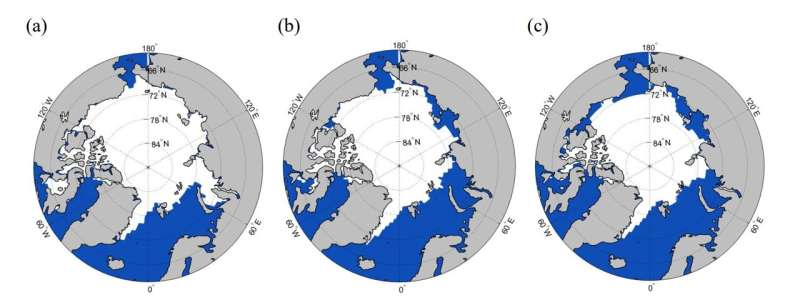This article has been reviewed according to Science X's editorial process and policies. Editors have highlighted the following attributes while ensuring the content's credibility:
fact-checked
peer-reviewed publication
trusted source
proofread
New reconstruction shows low Artic sea ice cover in mid-20th century

An international research team presented a new reconstruction of past Arctic sea ice that revealed low levels of sea ice coverage in the 1940s.
Their results were published on July 26 in a special issue of Advances in Atmospheric Sciences commemorating the life work of Professor Yongqi Gao who passed away in July 2021. The new reconstruction can help climate scientists adjust expectations of future sea ice coverage.
"Understanding the range of sea ice multi-decadal variations in the past, when the anthropogenic forcing was several times weaker than in the present day, is key for assessing mechanisms of climate variations and predicting future changes of the Arctic sea ice," said study co-author Vladimir Semenov from the A.M. Obukhov Institute of Atmospheric Physics, Russian Academy of Sciences.
The shrinking Arctic sea ice area in recent decades is a striking manifestation of ongoing climate change. This rapid transformation of the cryosphere has important consequences for Arctic ecosystems, society and economy, with impacts that extend to the mean surface temperature of the entire globe.
Since the late 1970s, satellites have been continuously observing seasonal variations of Arctic sea ice over decades. Sea ice variations have been relatively well monitored since the 1950s, but due to a lack of observations, there are no reliable estimates of the Arctic sea ice area in the middle of the 20th century. This period was characterized by a strong warming, known as the Early 20th Century Warming.
Previous studies established the link between surface air temperature and sea ice, which implies that the early 20th Century warming interval was accompanied by a concurrent reduction of Arctic sea ice, but the magnitude and extent of the decline were unclear.
The research team set out to understand the mystery surrounding sea ice anomalies during the 1940s, a period that instrumental observations indicate was almost as warm as today, according to study co-author Noel Keenlyside.
"Surprisingly, previous reconstructions of sea ice do not indicate a large reduction of sea ice," said Keenlyside from the Geophysical Institute, University of Bergen and Bjerknes Centre for Climate Research.
The team reconstructed the sea ice patterns in the period with poor data, before 1953, using established co-variability patterns between sea ice, sea surface temperature, and sea level pressure patterns. Constructing distinct regression models for three geographically separated regions—the Arctic Ocean, Bering Sea and the Sea of Okhotsk—improved the fit of the models and reduced uncertainty.
"Our reconstruction using independent data provides the first strong evidence for a large decline of sea ice in the 1940s," Keenlyside said. "This is exciting, because unlike the present warming, emitted anthropogenic greenhouse gases were relatively low."
The reconstruction, called the Institute of Atmospheric Physics sea ICE reconstruction version 1, provides a new baseline for assessing internal climate variability. According to the study, the ongoing sea ice area decline is already significantly beyond the level of internal climate variability—even assuming that the Early 20th Century Warming of the Arctic was primarily caused by internal climate variability. This indicates the importance of anthropogenic forcing.
"Our data can be used as boundary conditions for atmospheric models and reanalyses," Semenov said. "Performing atmospheric model simulations for the 20th century using our sea ice reconstruction may help to identify mechanisms of the Early 20th Century Warming anomaly."
Other contributors of the research include Tatiana A. Aldonina from the Institute of Geography Russian, Academy of Sciences, Fei Li from the Geophysical Institute, University of Bergen and Bjerknes Centre for Climate Research and Lin Wang from the Institute of Atmospheric Physics, Chinese Academy of Sciences.
More information: Vladimir A. Semenov et al, Arctic Sea Ice Variations in the First Half of the 20th Century: A New Reconstruction Based on Hydrometeorological Data, Advances in Atmospheric Sciences (2024). DOI: 10.1007/s00376-024-3320-x
Journal information: Advances in Atmospheric Sciences
Provided by Chinese Academy of Sciences





















